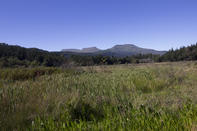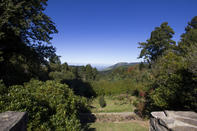The Fantasy Forests
I’ve got two words for you … Hobbit Country. If you’ve read ‘Lord of the Rings’ or seen the movie, the fantasy forests encircling this sleepy village of Hogsback will transport you into the very epicentre of modern-day Middle-Earth.

Hazy pine plantations, serene indigenous woodlands, forested kloofs and sweeping grassland slopes unfold here within the shadow of razorback ridges. Rambling inns, hideaway cottages and characterful pubs are sure to remind you of Frodo’s beloved Shire. Beyond the borders of the sleepy village, cascading waterfalls and tranquil streams will entice you to lose yourself within the surrounding Amathole ranges.
Hogsback is named after three ridged summits (reminiscent of bristly-backed wild pigs) and perches upon the western rim of the inland escarpment and overlooks the rural valley of Tyume. Hogsback is 85 km from King William's Town (situated on the N2 and R63). Travel west on the R63 towards Alice; after approximately 55 km turn right onto the R345, signposted ‘Cathcart/Hogsback’. From here it is around 30 km to Hogsback.
Leafy Mountain Village

This fairy-tale village is perched above the forested slopes of the far-away. The village’s rather peculiar name is derived from the local geology, with some people thinking that the nearby exposed ridges may be shaped like the bristles upon the back of a wild boar. Local crafters make full use of this geological quirk, doing a roaring trade in clay models of bristly hogs all along the main road. Quaint and weird jostle with tradition and charm as you wander through the tranquil streets of this leafy mountain village.
The beautiful old Hogsback Inn, dating back to the 1880s, as well as the stone-clad St Patrick’s-on-the-Hill (a thatched chapel built in 1935) are but two of the buildings capturing the timeless feel so typical of Hogsback. The change of season brings its own enchantment as the Samango monkeys, Knysna turaco and endangered Cape parrots revel in the forested surrounds.
An altitude of 1 273m means winters go hand-in-hand with roaring log fires, bracing mountain walks and regular snow falls. Spring, summer and autumn – in fact, all the seasons – are sure to lure you out of doors and into the surrounding woods, where mountain trails, giant tree ferns, the scent of mushrooms and myriad cascading waterfalls await.
Historic Battles in Hogsback
Gaika was a chief who, during the early conflicts between Xhosa and British, had sided with the latter. At the Battle of Amalinda in 1818, a combined force under Chief Ndlambe and prophet Makana defeated Ndalmbe's nephew Gaika, who fled into the Amatolas and took refuge with his people and their cattle on the mountain that now bears his name.
As Sandile succeeded his father Ngqika who died in 1829, so Sarhili, also known as Kreli, succeeded his father Hintsa in 1835. Then Harry Smith, as governor of the Cape, deposed Sandile as part of his ill-conceived plan to end the existing treaty system with the Xhosa.
In 1878, Sandile and Sarhili combined forces for a last campaign against the British. They attacked the fort at Kentani but were decimated by concentrated grapeshot fired by the British guns. This finally allowed the colonial government to annex the land of the Xhosa.
By Jacques Marais